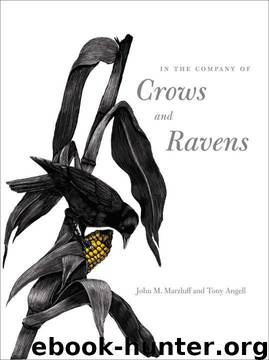In the Company of Crows and Ravens by John M. Marzluff

Author:John M. Marzluff [Marzluff, John M.]
Language: eng
Format: epub
Published: 2011-07-21T13:24:00+00:00
Yet is it legitimate to think of a crow's caw as part of a "language"? The American Heritage Dictionary defines language as "any system of signs, symbols, etc., used for communication." Scholars of animal linguistics de mand more. To be language, animal communication should consist of symbolic referents, the rules of syntax, and the ability to create new symbols and use them in novel and appropriate situations. Few animals come close to the human language's symbolism, syntax, and creativity, but we suggest that most corvid vocal communication systems meet at least the basic standards of a language. The clucking of Common Ravens symbolically represents a dangerous invader near the nest. But their trilling indicates a trespassing challenger. American Crows represent distant predators with ko calls. These vocal symbols have clear and consistent meanings, but they are arbitrary (that is, symbolic): Why has a trill come to represent a challenger rather than a predator? Not only are calls symbolic, but as we learn more about corvid vocalizations we are recognizing basic rules of syntax. The American Crow's caw, for example, is doubled in rapid succession to emphasize territorial defense, and Pinyon Jay alarm calls are combined with wavering contact calls to indicate increasing excitement by jays mobbing predators. The importance of syntax to the meaning of American Crow kaws has even been demonstrated experimentally. Psychologist Nicholas Thompson of Clark University recorded caws from wild crows, then remixed and replayed them to crows. Depending on how he arranged a sequence of cawing-as a structured versus an unstructured composition-Thompson could attract or repel crows with the same caws. Obviously, syntax, not just the symbol, makes a difference to the meaning. Still, many linguists would argue that these rules of grammar are too simple to qualify crow communication as a language. Human grammar regularly allows words to be rearranged and change a sentence's meaning. But human grammar also allows us to anticipate connections among words separated by other words of vastly different meaning. Words like "if" and "then" are an example. We do not know of such "recursive" properties in animal communication systems. Most corvids quickly in vent new vocal symbols and use them in appropriate and novel situations. One way they do this is by mimicking the sounds of other animals, inanimate objects, and human speech.'
Crow and raven vocal communication possesses the basic aspects linguists require of a language. But let's temper our interpretation a bit. Individual caws, quorks, and screams may often express general emotion or mood, like the grunts, cries, and screams of humans. Some calls or phrases have discrete meaning, like human words or sentences. They may be combined in complex ways and given in a variety of contexts to vary and enrich their meaning, but these are probably not constructed with the socially approved rules of grammar that we use to compose sentences and paragraphs. Rather, crows say what they see, feel, or need in a way that conveys information for their own benefit. Natural selection is their editor,
Download
This site does not store any files on its server. We only index and link to content provided by other sites. Please contact the content providers to delete copyright contents if any and email us, we'll remove relevant links or contents immediately.
| Amphibians | Animal Behavior & Communication |
| Animal Psychology | Ichthyology |
| Invertebrates | Mammals |
| Ornithology | Primatology |
| Reptiles |
Sapiens: A Brief History of Humankind by Yuval Noah Harari(14250)
The Tidewater Tales by John Barth(12608)
Mastermind: How to Think Like Sherlock Holmes by Maria Konnikova(7227)
Do No Harm Stories of Life, Death and Brain Surgery by Henry Marsh(6889)
The Thirst by Nesbo Jo(6826)
Why We Sleep: Unlocking the Power of Sleep and Dreams by Matthew Walker(6618)
Life 3.0: Being Human in the Age of Artificial Intelligence by Tegmark Max(5474)
Sapiens by Yuval Noah Harari(5294)
The Longevity Diet by Valter Longo(5019)
The Body: A Guide for Occupants by Bill Bryson(4974)
The Rules Do Not Apply by Ariel Levy(4859)
The Immortal Life of Henrietta Lacks by Rebecca Skloot(4525)
Animal Frequency by Melissa Alvarez(4395)
Why We Sleep by Matthew Walker(4359)
The Hacking of the American Mind by Robert H. Lustig(4318)
Yoga Anatomy by Kaminoff Leslie(4305)
All Creatures Great and Small by James Herriot(4232)
Double Down (Diary of a Wimpy Kid Book 11) by Jeff Kinney(4207)
Barron's AP Biology by Goldberg M.S. Deborah T(4096)
